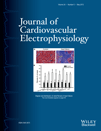JCE:既往存在胺碘酮相关甲亢的房颤患者导管消融后复发率较高
2013-05-02 JCE 丁香园
环肺静脉消融术是心房颤动的有效治疗手段,近年来随着消融技术的进展,越来越多的患者通过导管消融术根治了房颤,然而我们也认识到导管消融治疗房颤存在较高的复发率,因此寻找房颤复发的预测因素具有重要意义,既往多项临床研究表明左心房大小、高血压、高血糖及房颤的持续时间是房颤复发的预测因素,也有部分临床表明房颤后新发房性心动过速、持续性房颤、大面积的环肺静脉消融和左心房线状消融可预测房颤复发。目前认为存在并发
环肺静脉消融术是心房颤动的有效治疗手段,近年来随着消融技术的进展,越来越多的患者通过导管消融术根治了房颤,然而我们也认识到导管消融治疗房颤存在较高的复发率,因此寻找房颤复发的预测因素具有重要意义,既往多项临床研究表明左心房大小、高血压、高血糖及房颤的持续时间是房颤复发的预测因素,也有部分临床表明房颤后新发房性心动过速、持续性房颤、大面积的环肺静脉消融和左心房线状消融可预测房颤复发。
目前认为存在并发疾病可能影响房颤消融的成功率,甲状腺功能亢进是房颤患者常见的合并症,尤其是长期服用胺碘酮者。然而甲亢是否影响房颤消融的成功率目前还不清楚。甲亢可能促进左心房致心律失常基质的形成,因此胺碘酮相关的甲亢可能导致房颤的复发率增高,据此Mikhaylov EN等近来在JCE上发表了一篇临床研究。
该研究的对象为自2007年至2010年于作者中心行导管消融的房颤患者,其中20例既往存在胺碘酮相关甲亢,对照组选择胺碘酮治疗无效的且甲状腺功能正常的患者40例。所有患者均进行了环肺静脉消融术,平均随访12个月。结果显示:既往甲亢的患者中有6例没有房性心律失常发作,占30%,而对照组为62.5%。7例患者发作房性心动过速,占35%,而对照组为2.5%;10例患者发作心房颤动,占50%,而对照组为7.5%。进行再次消融时发现与消融线无关的心动过速有5例,占25%,而对照组没有;再次消融后房颤的无复发率为60%,对照组为70%,两组无明显统计学差异。胺碘酮相关甲亢是房性心律失常发生的独立预测因子。
通过该项研究可得出以下结论:存在胺碘酮相关甲亢的房颤患者单纯环肺静脉消融术后复发率较高,而经过再次消融后,房性心律失常的复发率与无甲亢的患者相当。
与房颤相关的拓展阅读:
- Neurology:植入性循环心电检测仪明显提高隐源性卒中的房颤检出率
- Neurology:新诊断房颤与晨起卒中和TIA独立相关
- Nat Rev Cardiol:瑜伽有助于改善房颤患者的房颤负荷
- CAE:房颤患者消融围手术期服用达比加群的安全性
- ACC 2013:房颤患者首次应用地高辛死亡率升高
- Ann Intern Med:房颤增痴呆风险再添新证 更多信息请点击:有关房颤更多资讯

Catheter Ablation of Paroxysmal Atrial Fibrillation in Patients with Previous Amiodarone-Induced Hyperthyroidism: A Case-Control Study.
INTRODUCTION
Many patients with atrial fibrillation (AF) receive amiodarone. Amiodarone-induced hyperthyroidism (AIH) may develop as a complication. We hypothesized that pulmonary vein (PV) isolation in patients with paroxysmal AF and history of AIH may yield a lower success rate.
METHODS AND RESULTS
Among 704 patients who underwent AF ablation in our center between 2007 and 2010, we identified 20 patients (mean age 58.3 ± 5.0 years; 11 males) with paroxysmal AF and overt AIH in the past. The control group consisted of 40 patients with amiodarone-refractory AF and no thyroid dysfunction. All patients underwent circumferential PV isolation. During redo procedures all tachycardias were targeted for ablation. During a 12-month follow-up, in the AIH group 6 (30%) patients were arrhythmia free after a single procedure, in comparison to 25 (62.5%) controls (P = 0.01). Atrial tachycardia (AT) was registered in 7 (35%) AIH patients and in 1 (2.5%) control patient (P = 0.001). AF recurred in 10 (50%) AIH versus 15 (37.5%) control patients (P = 0.2). Redo ablation was performed in 7 (35%) AIH patients and in 3 (7.5%) non-AIH patients (P = 0.01). During a redo procedure a PV-unrelated tachycardia was diagnosed in 5 (25%) AIH patients (vs 0 in the controls, P = 0.003). After the last performed ablation, 12 (60%) AIH patients and 28 (70%) controls had no recurrence, P = 0.56. AIH was an independent predictor of ATs.
CONCLUSION
PV isolation alone has a lower efficacy for preventing recurrence in paroxysmal AF in AIH patients. After repeat ablations, overall freedom from tachyarrhythmias is similar to patients with no history of thyroid dysfunction.
作者:JCE
版权声明:
本网站所有注明“来源:梅斯医学”或“来源:MedSci原创”的文字、图片和音视频资料,版权均属于梅斯医学所有。非经授权,任何媒体、网站或个人不得转载,授权转载时须注明“来源:梅斯医学”。其它来源的文章系转载文章,本网所有转载文章系出于传递更多信息之目的,转载内容不代表本站立场。不希望被转载的媒体或个人可与我们联系,我们将立即进行删除处理。
在此留言





#JCE#
40
#复发率#
35
#胺碘酮#
27
#导管消融#
39
#消融#
46